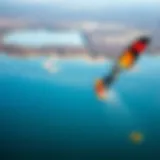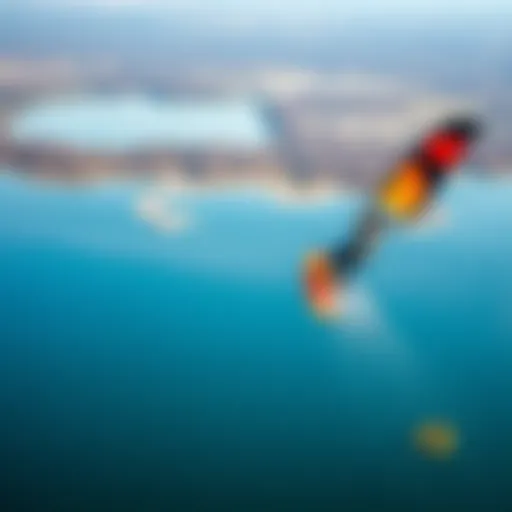Mastering Kiteboarding: Your Complete Guide
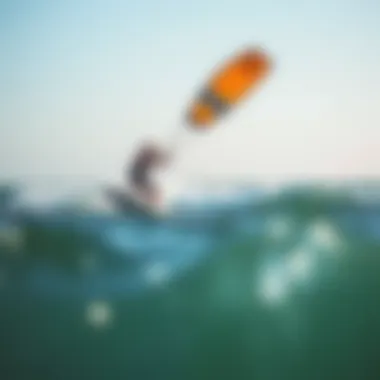

Intro
Kiteboarding, a spectacular fusion of surfing, windsurfing, and paragliding, has carved out a unique niche in the world of water sports. The rush of gliding across the water, driven by the wind, offers an exhilarating experience that captivates a diverse range of enthusiasts—from beach bums to thrill seekers. Yet, amidst the splashes and breezes lies a realm demanding respect, skill, and knowledge. This guide seeks to illuminate the various facets of kiteboarding, providing essential information for both newcomers and those who have already caught the kiteboarding bug.
The significance of mastering kiteboarding can't be overstated. For beginners, understanding the gear is crucial. It’s like learning to ride a bike; you can’t just hop on and expect to soar as if you’ve been doing it for years. The seasoned kiteboarders, on the other hand, understand that continually honing techniques and maintaining gear ensures both safety and adventure. Throughout this guide, we’ll peel back the layers of this complex sport, dive into proper techniques, discuss gear maintenance, and highlight safety measures, knitting together a vibrant tapestry of kiteboarding expertise.
Gear and Equipment
Essential Kiteboarding Gear: A Comprehensive Guide
In the realm of kiteboarding, the right gear can make or break an experience. Here’s a succinct breakdown of the essential equipment:
- Kite: The very heart of kiteboarding, available in different shapes and sizes, impacting your ride and enjoyment. Choose one that suits your skill level and the wind conditions.
- Board: Styles vary from twintips to directional boards. Selecting the right board means considering your personal style and the type of riding you wish to achieve.
- Harness: Comfort and security are key. A well-fitted harness distributes the kite's pull evenly and allows for freedom of movement.
- Lines and Control Bar: Essential for steering, they connect the kite to the harness. Inspect them regularly for any wear or damage.
- Safety Gear: Don’t skimp on safety. A kiteboarding helmet and impact vest can save you from unexpected bumps.
Each piece of gear plays a crucial role in your kiteboarding journey.
Maintenance Tips for Kiteboarding Equipment
Proper maintenance of your kiteboarding gear is like tending to a classic car; your investment deserves care. Here are basic tips that can extend the lifespan of your equipment:
- Kite Care: Rinse your kite with fresh water after every session to prevent salt and sand buildup. Store it in a cool, dry place to avoid UV damage.
- Board Inspection: Regularly check for dings or cracks in your board. If you spot any damage, repair it promptly to prevent further issues.
- Harness Check: Watch for wear on the webbing and buckles. A frayed harness could lead to mishaps on the water.
- Line Management: Tangle-free lines are essential for optimal performance. Store them neatly and check for frays.
"Invest in your gear's longevity; it's not just about the thrill but also about safety and preparedness."
Techniques and Skills
Beginner Techniques to Get Started with Kiteboarding
For those just getting their feet wet—literally—starting with basic techniques is essential. Here’s a step-by-step overview:
- Learning the Wind: Understanding wind patterns is fundamental. Find a location with consistent winds to practice.
- Kite Control: Practice flying your kite on land. Gain a feel for how the kite responds to different inputs and becomes one with the wind.
- Body Dragging: This is the art of being pulled through the water without a board. Perfecting this skill is key for understanding how to control your body while attached to the kite.
- Getting Up on the Board: Once you’re comfortable with body dragging, it’s time to move on to standing up without losing control of the kite.
Mastering these beginner skills lays a solid foundation for your kiteboarding journey.
Advanced Maneuvers for Seasoned Kiteboarders
Once you’ve established a few tricks in your repertoire, it’s time to step it up. Here are advanced maneuvers worth mastering:
- Jumping: The thrill of getting air is unmatched. Begin with small hops and gradually increase your height as confidence builds.
- Board-off Tricks: This involves removing the board while in the air, displaying skill and style.
- Transitions: Mastering seamless movements when changing direction is crucial for smooth riding.
- Wakestyle Tricks: These tricks rely heavily on the power of the kite, making them challenging yet rewarding. Learn how to combine kite power with precision edging.
Dedicating time to these advanced techniques not only enhances your skills but also elevates the overall kiteboarding experience.
Feel free to further explore detailed guides and information through resources such as Wikipedia, Britannica, and forums on Reddit. With practice, knowledge, and the right gear, kiteboarding can quickly switch from a whim into a lifelong passion.
Foreword to Kiteboarding
Kiteboarding is not just a sport; it’s an exhilarating blend of aerial acrobatics and oceanic adventure. This sport has grown significantly since its inception, and today, kiteboarding enthusiasts span the globe. Understanding the basics of kiteboarding is critical for anyone looking to take the plunge into this thrilling experience. The introductory section of this article aims to clarify why kiteboarding is worth the investment of time and resources.
Many people are daunted by the idea of learning a seemingly complex sport, yet kiteboarding also offers numerous mental and physical benefits. For instance, it enhances core strength, improves balance, and fosters a deep appreciation for nature. Each session on the water presents an opportunity to connect with the environment in a truly unique way.
Key Benefits of Kiteboarding
- Physical Fitness: Kiteboarding engages multiple muscle groups. Riders enhance their stamina and flexibility while tackling the elements.
- Mental Resilience: The sport challenges your ability to stay calm under pressure, teaching valuable lessons in patience and determination.
- Community Connection: Kiteboarding isn’t just an individual pursuit; it’s woven into a global network. Enthusiasts often discover friendships and camaraderie on the beach or at competitions.
Nevertheless, as with any adventure, there comes a need for caution. Understanding the risks and learning how to mitigate them is crucial. The fabric of kiteboarding rests not only on the exhilaration of soaring above water but also on the responsible behaviors of its practitioners.
The Evolution of Kiteboarding
Kiteboarding has traveled quite the journey since its roots in the late 20th century. The sport is a fusion of various styles of boarding and kiting that originated from activities like windsurfing and surfing. In the 1980s and 1990s, early pioneers experimented with different designs, leading to the first commercial kiteboards hitting the market. Over the years, technological advancements transformed these early models into the sleek, efficient models we see today. Each iteration not only improved performance but also emphasized safety, which is paramount in enhancing user experience. If we take a closer look, we see how aerodynamic improvements have made kites easier to control, allowing riders to push their limits.
Milestones in Kiteboarding History
- 1990s: The introduction of inflatable kites changed the game, giving rise to a new generation of riders.
- 2000: Kiteboarding made its first appearance in the X Games, marking a significant step toward mainstream recognition.
- Present Day: Continuous innovations in materials and design keep pushing the boundaries of what’s possible, with electric kites and hydrofoils emerging as the latest trends.
This historical context not only informs enthusiasts about the foundations of their sport but also highlights its dynamic evolution.
Understanding the Mechanics
To truly master kiteboarding, one must first grasp the underlying mechanics that dictate how a kite interacts with both wind and water. Understanding these basic principles can significantly improve performance and safety on the water.
Kiteboarding relies heavily on the physics of lift and drag. The kite generates lift through angled surface areas, allowing riders to soar across the waves while remaining tethered to the power source—the kite itself. The position of the rider, especially when changing direction, also plays a vital role in controlling speed and precision.
Moreover, adjusting the trim of the kite—through varying lines or settings—will also impact responsiveness. Kiteboarders must learn how to read wind patterns and adjust their technique accordingly to ensure they’re not just hanging on for dear life but soaring with grace and purpose.
"Understanding kite mechanics is like learning a new language; it transforms your experience from one of struggle to one of fluidity."
By delving deeper into mechanics, riders can avoid common pitfalls, like oversteering or mishandling the kite in challenging conditions. With a firm grasp on these concepts, the ability to experiment with advanced maneuvers will blossom.
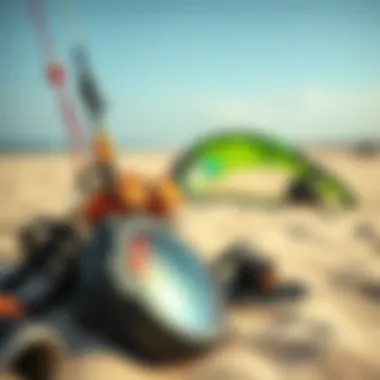

Getting Started with Kiteboarding
Getting into kiteboarding can feel like stepping into uncharted waters. The thrill of harnessing the wind, paired with a board beneath your feet, opens up an exhilarating world of adventure. Starting with kiteboarding is not just about picking up necessary equipment; it's about embracing a lifestyle rooted in balance, coordination, and respect for nature. The benefits extend far beyond the moment you skim atop the water or perform a trick. Kiteboarding fosters physical fitness, builds mental resilience, and connects you with a vibrant community passionate about the sport.
When setting off on this journey, it’s crucial to understand a few key elements. Safety, gear selection, and personal skill development are paramount as they lay the foundation for both enjoyment and progression in kiteboarding. With proper equipment tailored to your level and understanding of the sport's demands, you'll be in a much better position to make your start an enjoyable one.
Choosing Your First Kite
Selecting your first kite can be a game changer in your kiteboarding experience. It's essential to consider factors like size, type, and intended use. For beginners, the size of the kite should be matched with your weight and the usual wind conditions in your chosen location. A larger kite catches more wind but can be overwhelming in strong winds, while a smaller kite may limit your ability to get enough lift. Using the right size ensures that you can learn without feeling overpowered. Popular choices among novices often lean towards all-around kites; they provide good lift and versatile performance in varied conditions.
Beyond size, you should also look into the construction quality and safety features of the kite. A reliable model constructed from durable materials helps ensure longevity as you learn to navigate the waves, while safety features like a quick-release system can be lifesavers in emergencies. Learning how to operate your kite effectively will greatly enhance your skills and confidence on the water.
Essential Equipment Overview
To get started, you need to piece together your essential equipment. Kiteboarding isn’t just about the kite; every component plays a crucial role in delivering an enjoyable experience.
Selecting a Board
Choosing the right board is vital for your success on the water. Boards come in different shapes, sizes, and flex ratings. A wider board, for instance, will offer more stability and is easier for novice kiteboarders to maneuver. This stability can help you feel secure as you get to grips with controlling the kite. On the other hand, a board with a narrower design can provide higher speed and agility, making it a popular choice for more experienced riders.
One unique feature of many boards today is the pad and strap system, which allows a customizable fit for maximum comfort and grip. However, some boards may have a steep learning curve, so it's often advisable to start with a design that focuses on stability over performance.
Understanding Harness Types
Harnesses connect you to your kite, so selecting the right one is critical. Kiteboarding harnesses can be designated as waist or seat types.
- Waist harnesses sit higher on your body and are generally favored by freestyle riders; they allow for better movement but require better body positioning.
- Seat harnesses offer more support and are recommended for newcomers, as they distribute weight more evenly across your hips and lower back.
A feature worth mentioning is the quick-release mechanism, which enhances safety by enabling prompt disconnection from the kite in emergencies. Properly fitting harnesses can also prevent aches or chaffing while riding, making your experience much more enjoyable.
Safety Gear Essentials
Safety is non-negotiable when it comes to kiteboarding. The right gear can make all the difference between a thrilling experience and one fraught with danger. A reliable helmet is crucial to protect your noggin from possible impacts. Look for models that fit well, are lightweight, and provide ventilation. Additionally, impact vests serve another layer of protection, especially for beginners who may experience falls more frequently.
Wearing leash systems is also strongly recommended, as they keep you connected to your gear during rides and prevent loss of your kite in high winds. While all safety gear may feel cumbersome initially, remember that its primary function is to help you enjoy and explore the sport while minimizing risk.
Connecting with the kiteboarding community through local forums or social media groups can also help you get insights on safety practices and gear recommendations specific to your area.
Remember that kiteboarding is not just a sport; it’s an adventure. Taking the right steps at the beginning can ensure a safe and fun experience.
As you embark on this captivating journey into kiteboarding, focus on the essentials and ensure that you are well-equipped to take on the challenges and joys ahead.
Skill Development in Kiteboarding
When it comes to kiteboarding, mastering the requisite skills is like laying the foundation for a sturdy house. Skill development is essential not just for enhancing one’s enjoyment on the water but also for ensuring safety and a positive experience. As kiteboarding evolves, new techniques and maneuvers emerge, making it vital for both novices and veterans to hone their skills continually.
By focusing on essential techniques, one can build confidence and develop a personal style that suits individual preferences and abilities. This section delves into both fundamental techniques and advanced maneuvers, providing an understanding that caters to all levels of expertise.
Fundamental Techniques
The fundamental techniques are the bread and butter of kiteboarding. They constitute the basic skills every kiteboarder should master before moving on to more complex maneuvers.
Controlling Your Kite
Controlling your kite is like steering a ship; mastering this aspect is pivotal for any kiteboarder. Proper kite control allows riders to navigate winds, adjust height, and effectively manage speed. This skill is essential not just for routine maneuvers but also for safety. A kite that is failing to respond to commands can lead to precarious situations.
A notable feature of kite control is the use of the bar and lines to maneuver the kite as needed. This provides a direct response that is crucial for riding effectively. While the learning curve can be steep, once achieved, it opens up a world of possibilities on the water, enabling the kiteboarder to perform tricks and navigate difficult conditions with ease.
Momentum and Speed
Momentum and speed take the foundation of kiteboarding to the next level. Understanding how to harness speed enables kiteboarders to flow seamlessly across the water, achieving the desired level of performance. Proper momentum management allows for effective transitions and turns without losing control.
The unique feature of maintaining speed lies in using the power of the kite – using the wind rather than the rider's strength alone. This keeps energy expenditure down while allowing for a more effortless ride. However, it requires a keen awareness of the wind's dynamics, which may be challenging but ultimately rewarding as it enhances riding capability.
Executing Turns
Executing turns properly is a critical element that defines a skilled kiteboarder. It's much more than just turning the board; it's about timing and positioning. A well-executed turn utilizes body weight and kite positioning simultaneously, providing a seamless flow in movement.
The key characteristic here is precision. When riders learn to balance their weight over the board while steering the kite during a turn, they increase stability and control, which is vital for more advanced maneuvers in the future.
Advanced Maneuvers
Once grip on the fundamentals is solid, it’s time to delve into advanced maneuvers that add flair and excitement to kiteboarding.
Jumping Techniques
Jumping techniques are the crown jewels of kiteboarding. They not only elevate the experience but also demonstrate a rider’s prowess. Proper jumping requires an understanding of timing, kite control, and body position. The key characteristic here is the lift generated by the kite as it catches the wind, offering that exhilarating feeling of flight.
However, along with the thrill comes the need for accuracy and control. Landings can be tricky and require practice and the right technique to avoid falls. As such, while jumps enhance style and performance, they do come with their challenges, which makes mastery of this area immensely rewarding.


Tricks to Explore
Tricks to explore are a realm of opportunity for creativity within kiteboarding. They embody a form of expression that showcases personality and style, allowing riders to stand out. The combination of flips, spins, and rotations showcases not just skill but a whole new level of excitement.
A hallmark of this segment is the learning curve involved in mastering various tricks. Some tricks are easier than others, yet they each add to the overall experience. Riders need to experiment and find what resonates with them, making this journey both personal and fun.
Mastering Transitions
Mastering transitions is crucial for maintaining momentum and flow in kiteboarding. Transitions ensure that every aspect of riding is interconnected, allowing for fluid movements from one trick into another. The characteristic here lies in the ability to shift focus quickly from direction to direction, maintaining the ride's rhythm.
This method not only shows confidence but also enhances the rider's overall capability on the water. However, it may require more practice to achieve seamless transitions, indicating that the learning never truly stops in kiteboarding.
By focusing on developing these skills, kiteboarders can carve out a personal niche within the sport. It’s this constant evolution of skill that keeps the water fresh and exciting, propelling riders toward continuous improvement and adventure.
Safety Protocols in Kiteboarding
When it comes to kiteboarding, safety is not just important—it's paramount. Like a lighthouse guiding ships through stormy waters, having robust safety protocols can mean the difference between a thrilling session and a disastrous one. The unpredictable nature of wind and water makes it essential for kiteboarders, be they newbies or seasoned pros, to lace up their safety knowledge before they hit the waves. Through understanding local conditions and implementing solid emergency procedures, participants can enjoy the sport to its fullest without unnecessary risks.
Understanding Local Conditions
Before gearing up, understanding local conditions is vital. Assessing wind patterns and evaluating water conditions lays the groundwork for a safe and enjoyable session.
Assessing Wind Patterns
Wind can be a fickle friend or a relentless foe in kiteboarding. Recognizing wind patterns involves observing direction, consistency, and speed. A steady onshore breeze might signal a good day–the kind where you bounce through the air with grace. However, uneven gusts can create rip currents, turning a fun day into an unpredictable adventure.
- Key Characteristics: The most reliable assessment often hinges on local weather forecasts and real-time observations. A clear understanding helps kiteboarders choose the right time to start.
- Advantages: Familiarizing yourself with regular wind patterns at particular spots ensures safety and enhances the overall experience.
- Disadvantages: Misreading wind conditions can lead to unforeseen hazards, emphasizing the need for continuous learning and observation.
Evaluating Water Conditions
Similarly, evaluating water conditions is crucial. Choppy waters can pose challenges that smooth surfaces simply don't. Knowing whether the spot you're targeting is rife with submerged rocks or gentle sandbars influences how your session unfolds.
- Key Characteristics: Factors like tide levels, currents, and hidden hazards should always be checked. Understanding these aspects allows for informed decisions and risk assessment.
- Advantages: A well-evaluated water situation can help in choosing the best practices and techniques, leading to a smoother ride.
- Disadvantages: Overlooking these factors can expose you to accidents like falls or kite entanglements, which can result in serious injuries.
Emergency Procedures
Kiteboarding, like any extreme sport, comes with risks. It’s wise to have emergency procedures at the forefront—think of them as your mental safety net allowing you to navigate unexpected situations with poise.
Self-Rescue Techniques
Knowing how to perform self-rescue techniques is a non-negotiable skill. This is your quick ticket back to safety should unexpected elements come into play.
- Key Characteristics: Techniques might involve releasing tension on the lines to create a safer situation. Learning to re-launch your kite is also paramount.
- Advantages: Effectively utilizing self-rescue techniques enhances independence and minimizes reliance on others, increasing overall confidence.
- Disadvantages: Improper use of rescue techniques can endanger the individual further, making accurate training imperative.
Communicating with Others
Effective communication with fellow kiteboarders is often overlooked but crucial. It's like having a buddy system, ensuring everyone is aware of potential dangers and conditions.
- Key Characteristics: Clear hand signals or radios can maintain connection between riders, especially in crowded spots.
- Advantages: This approach reduces the chances of accidents while fostering a sense of camaraderie.
- Disadvantages: Poor communication or misinterpretation can lead to accidents that are entirely avoidable, punctuating the need for clear dialogue.
Always remember: Safety first, fun will follow. Having a comprehensive grasp of local conditions and emergency procedures ensures that kiteboarding remains the exhilarating sport it was meant to be.
In summary, safety protocols are the backbone of kiteboarding. By assessing local conditions and knowing emergency procedures, riders can enhance their experiences while ensuring effective safety management on the water.
Exploring Kiteboarding Locations
Understanding the idea of kiteboarding locations is like finding the right canvas for your masterpiece. The backdrop, the wind, and the water are not just elements of your experience; they define it. The significance of exploring various kiteboarding locations is fundamental, as each spot brings unique challenges, styles, and thrills to the table. It offers the opportunity to connect with different kiteboarding cultures while broadening your skills in diverse environments.
Best Destinations Worldwide
When you think about the crème de la crème of kiteboarding spots, certain destinations pop into mind. Places like Maui, known for its gnarly waves and consistent winds, attract riders from all corners of the globe. Spot after spot, the thrill of kiteboarding invigorates when executed under the right conditions. Other extraordinary locations include:
- Tarifa, Spain: Infamous for its gusty winds and rich kiteboarding scene.
- Cumbuco, Brazil: Flat waters and constant breezes make it a kitesurfer's paradise.
- Cape Town, South Africa: A perfect blend of waves and stunning scenery.
Traveling to these places, you not only discover new techniques but also meet fellow kiteboarders who share your passion. The local kiteboarding community often welcomes newcomers with open arms, sharing tips and tricks peculiar to the area.
Understanding Regional Styles
Flat Water vs. Waves
Diving deeper into the regional styles, one can compare the experiences of flat water versus wave riding. Flat water is usually gentler, perfect for learning and mastering basic skills. The smooth surface makes it easier for beginners to practice maneuvers and gain confidence.
On the flip side, wave riding presents a more exhilarating challenge for those seeking the rush. Waves add an element of unpredictability, demanding agility and skill to navigate efficiently. Whether choosing flat water or waves largely depends on your experience level and comfort with kiteboarding. Each has their own advantages.
- Advantages of Flat Water:
- Disadvantages of Flat Water:
- Easier to learn and practice tricks.
- Fewer variables to affect your ride.
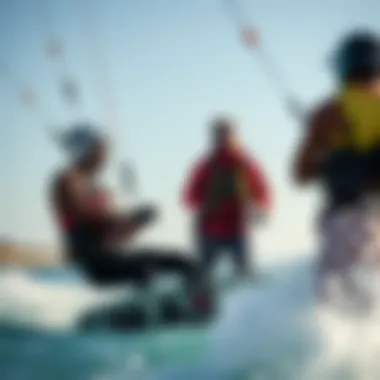

- Lacks the dynamic challenges offered by waves.
"Catching a wave is like dancing on water's rhythm, you feel each pulse and power."
Windy vs. Calm Environments
Next, let’s discuss windy versus calm environments. Windy locations typically offer a consistent breeze, making them popular among seasoned kiteboarders. Here, the trick is not just to ride but to harness the wind's energy to perform remarkable jumps and tricks.
Calm environments, however, have their perks for newcomers. You can fine-tune your balance and practice flying the kite without the gusts throwing you off your game.
- Key characterstics of Windy Environments:
- Key characteristics of Calm Environments:
- More capable of performing dynamic moves.
- Challenging conditions help improve skills fast.
- Opportunity for guided learning.
- Discover your connection with the kite and water.
In summary, whether you're in the rolling waves of Cape Town or the tranquil waters of Cumbuco, each kiteboarding location offers a wealth of experiences that contribute to your growth as a kiteboarder. Embrace the surroundings, learn from them, and let them shape your kiteboarding journey.
Community Engagement in Kiteboarding
Community engagement plays a pivotal role in kiteboarding, creating a tapestry of relationships and shared experiences that enhance the sport for participants at every level. Much like a vibrant coral reef sustains countless species, a strong kiteboarding community cultivates camaraderie among kite enthusiasts, fosters mentorship opportunities, and offers essential support for those entering the sport. Whether you're a seasoned kiteboarder or just dipping your toes into the wind and water, engaging with local communities can provide invaluable insights and connections.
The benefits of community engagement are manifold:
- Knowledge Sharing: Local clubs and groups often serve as platforms for knowledge exchange. Members share tips about equipment, techniques, and locations. This face-to-face interaction can often impart wisdom and information that books or videos simply can't replicate.
- Support Systems: Kiteboarding, while exhilarating, can also be dangerous. A supportive community can act as a safety net. Understanding that there are others looking out for you can help reduce the fears or anxieties of newcomers who may feel overwhelmed as they navigate challenges.
- Social Connections: Kiteboarding is as much about the people as it is about the sport. Forming friendships and meeting fellow enthusiasts can turn solitary practice into shared adventures. Events organized by clubs can create lasting bonds and unforgettable memories.
Engaging with the kiteboarding community also comes with considerations. Not all clubs are created equal; some may have rigid structures or membership fees. However, the potential benefits largely outweigh potential downsides. Finding the right club can lead to places you never knew existed and experiences that stay with you for a lifetime.
Connecting with Local Clubs
Finding the right local club can significantly elevate your kiteboarding journey. These clubs often act as a central hub where enthusiasts gather to hone their skills, share stories, and plan outings. Before jumping in, take a moment to assess the environment of the club. Is it welcoming? Do they offer beginner programs?
Local clubs frequently provide resources like lessons, group outings, and access to gear, which can save you a fair amount of cash and trial-and-error issues. You'll not only learn proper techniques but also gain insights about local conditions. Building relationships in these circles can give you the inside track on the best spots for kiteboarding while keeping safety and camaraderie in the forefront.
Participating in Competitions
Competing can be another layer to your kiteboarding experience. Events can take various forms, from friendly local contests to international championships. Each competition offers a unique taste of what kiteboarding can offer but it's important to understand the structure and dynamics involved.
Understanding Event Structures
Almost every kiteboarding competition has its own structure, whether it’s freestyle, racing, or wave riding. Knowing how events are structured can help hugely in your preparation.
- Freestyle usually emphasizes tricks and style, where points are awarded based on complexity and execution.
- Racing often involves timed courses, emphasizing speed and strategic maneuvering.
- Wave Riding competitions focus on the quality of waves and rider’s skill in handling them.
By understanding these distinctions, you can choose events that align with your strengths or areas you wish to improve. Furthermore, knowing the structure can help ease pre-competition nerves; after all, familiarity with the rules is a significant confidence booster.
Preparing for Your First Competition
Taking the plunge into your first competition can be both thrilling and intimidating. Preparation is key here, as it can make or break your experience.
- Practice Makes Perfect: The golden rule is to practice regularly. Build your confidence on the water, focusing on technique and style.
- Mental Readiness: Visualize your performance beforehand. This mental rehearsal can really help calm competition jitters.
- Gear Check: Ensure that your equipment is in top-notch condition. Competition day isn’t the time for surprises—double-check everything from your kite to your harness.
While the experience can be cut-throat and nerve-wracking, your first competition can also unfold many new opportunities. Whether you take home a trophy or simply gain confidence and connections, participating will enrich your kiteboarding narrative tremendously.
Engaging in the kiteboarding community by connecting with local clubs and participating in competitions can dramatically enhance not only your skills but also your appreciation for the sport. Both avenues encourage diversity in experiences and relationships, showcasing just how rewarding kiteboarding can be beyond the thrill of the wind and water.
Future Trends in Kiteboarding
As kiteboarding continues to rise in popularity, certain trends are shaping its future. Understanding these trends is imperative for enthusiasts to stay ahead of the curve. Innovative technologies and mindful environmental practices stand out as pivotal elements that will dictate the evolution of the sport. By being aware of these changes, kiteboarders can not only enjoy improved experiences but also contribute positively to the sustainability of their beloved waters.
Emerging Technologies
In the realm of kiteboarding, technology is consistently evolving to enhance performance and safety. One significant development is the rise of advanced materials that are lighter yet more durable. For example, the introduction of high-strength fabric composites not only improves the longevity of kites but also enhances maneuverability. The infusion of smart technology, like GPS tracking in kites, allows riders to monitor conditions in real-time, making informed decisions on wind patterns and safety.
Moreover, electric kiteboarding boards are becoming more common. These boards, equipped with battery-powered motors, enable riders to glide over water even in light wind conditions. This change opens possibilities for new riders who may find it difficult to harness wind power initially. Overall, embracing these technologies can mean an exhilarating ride, making all participants eager To upgrade their gear sooner, rather than later.
Environmental Considerations
As the kiteboarding community grows, the impact on the environment becomes an increasing concern. Enthusiasts are increasingly prioritizing eco-friendly practices that ensure the sustainability of their sport, contributing positively to natural habitats.
Sustainable Practices in Kiteboarding
Sustainable practices in kiteboarding typically focus on reducing waste and using materials that are environmentally responsible. One outstanding aspect of these practices is the shift towards recycled materials in the production of kites and boards. This change not only lessens the carbon footprint but also appeals to a growing segment of eco-conscious consumers who are willing to invest in products that align with their values.
The characteristic that stands out is transparency in the manufacturing process. Brands that share their production details tend to foster trust among consumers. This creates a sense of personalized connection, emphasizing that consumers are part of a larger movement toward sustainability. Though the prices for eco-friendly gear may be higher, the long-term benefits and reduced environmental impact can tilt the scales in favor of sustainable options.
Protecting Marine Ecosystems
A salient aspect of protecting marine ecosystems involves advocating for cleaner beaches and waters, vital to maintaining the beauty of kiteboarding locations. The kiteboarding community often champions this cause through local clean-up efforts and environmental education campaigns. A key characteristic of these initiatives is the collaboration between local clubs and environmental organizations, ensuring that their activities not only promote the sport but also safeguard the environment.
The unique feature of these efforts lies in their grassroots nature; anyone can participate, making it inclusive and community-oriented. Notably, the awareness they bring can help not just kiteboarders but the broader recreational public to respect and cherish natural settings. While the challenge lies in mobilizing consistent participation and funding, the dual rewards — a healthy environment and a more robust sport community — are certainly worth the endeavor.
"The true essence of kiteboarding isn’t merely in the thrill of the ride but in the responsibility we hold to protect our aquatic playgrounds."
By tuning into these trends and aligning with them, kiteboarders can not wield the wind merely for personal enjoyment but also for contributing to a wider cause, ensuring that future generations of enthusiasts can ride the waves in pristine conditions.












